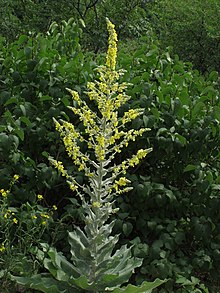|
Verbascum pulverulentum
Verbascum pulverulentum, the hoary mullein,[2] is a species of flowering plant in the family Scrophulariaceae.[3] It is native to western, central and southern Europe north to England (where its main range is in East Anglia) and southern Wales.[2] It has been introduced to Austria, Madeira, and Washington state in the USA.[1][4] It is a specialist on coastal shingle, and so is preadapted to human-influenced habitats such as old quarries and gravel pits, road verges, railway embankments, and similar disturbed stony ground.[5] It is a stout biennial or monocarpic perennial herb growing up to 1.5 m tall, producing flowers and seeds only once, during its second or a later year. The stems and leaves are densely woolly with pale grey to glaucous pubescence. The flowers are yellow, 18–25 mm diameter, with 5 orange stamens, all the stamen stems with dense white hairs.[6][7][2] It can best be distinguished from the similar great mullein (V. thapsus) in all five stamens having dense white hairs on the stem; in V. thapsus, the lower two of the five stamens are hairless or only thinly hairy.[6] It is the main food plant for the moth Nothris verbascella (Norfolk snout).[8] References
|
||||||||||||||||||||||||||||||||||||||

